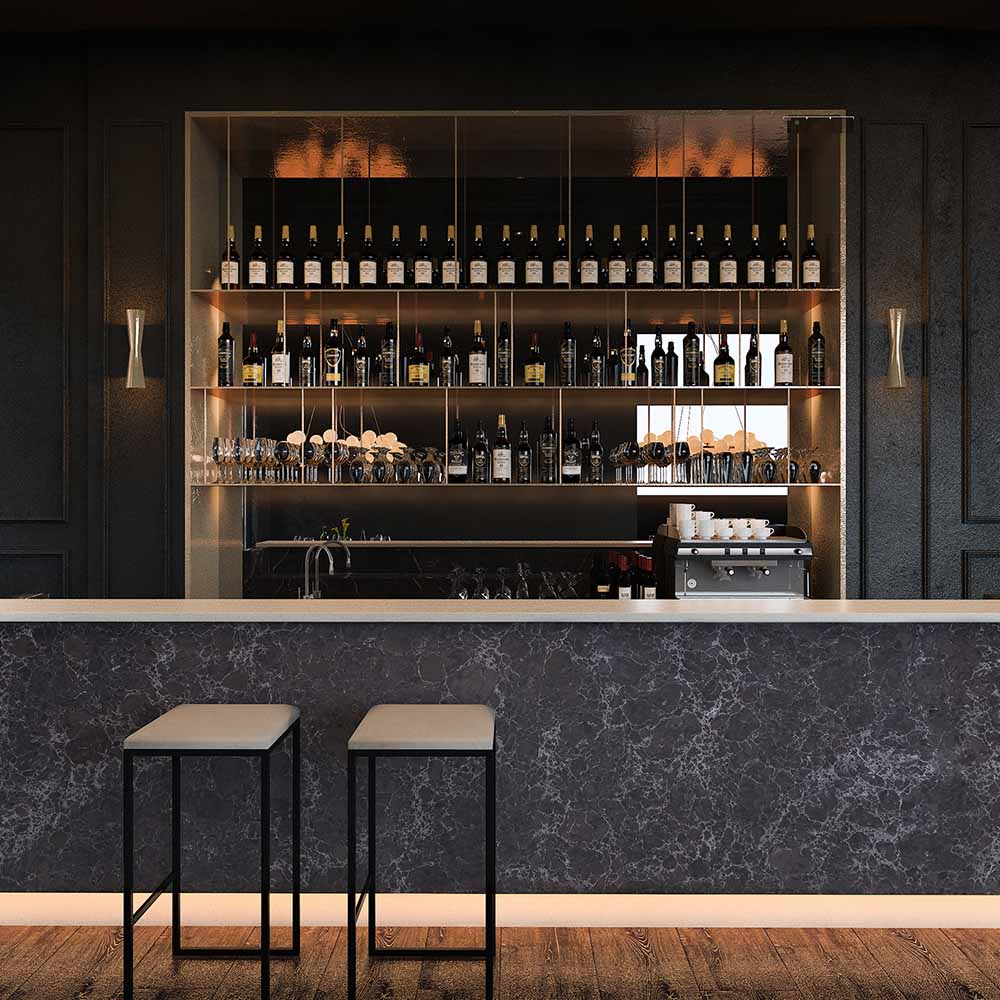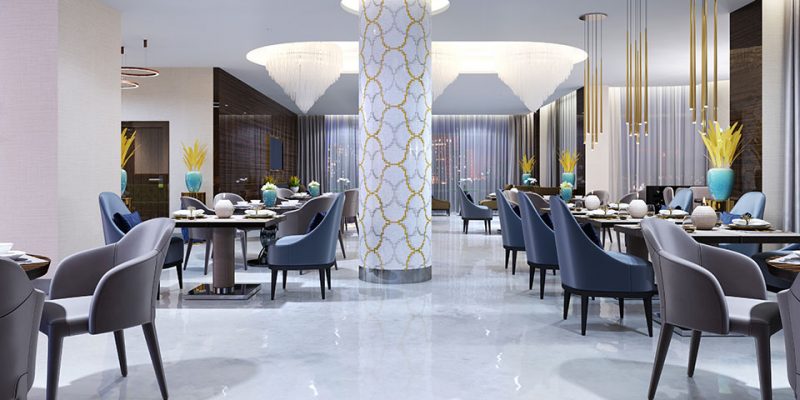The Role of Interior Design in Enhancing Dining Experiences
How to use of marble in the design of cafes, bars, and restaurants? The Importance of Interior Architecture in Restaurant and Bar Designs! Nowadays, restaurants with the most impressive and comfortable interiors are preferred to get away from the hectic pace of work and the crowds of the city or to have a celebratory dinner. Therefore, the interior design of a newly opened restaurant, cafe or bar is of great importance in order to increase brand awareness and satisfy customers.

This article may interest you: Customizing Your Space: Innovative Design Ideas with Silestone Quartz
Marble: A Touch of Elegance in Restaurant and Bar Interiors
In this context, the use of marble in interior design emerges as a significant element in creating an ambiance that resonates with sophistication and quality. Marble, known for its durability and timeless beauty, adds a touch of elegance and luxury to any space. Its unique veins and array of colors make it a versatile material that can be integrated into various design themes, from classic to contemporary. In cafes, bars, and restaurants, the application of it in countertops, flooring, or accent walls can significantly elevate the aesthetic appeal of the space. It not only enhances the overall look but also contributes to creating an environment that is both inviting and memorable for patrons. By incorporating marble, establishments can distinguish themselves from competitors, offering an upscale and distinct dining or leisure experience that appeals to the discerning tastes of customers. Thus, the strategic use of it in interior design is not just an investment in the physical space, but a crucial aspect of branding and customer satisfaction in the highly competitive food and beverage sector.
Embracing Differentiation in the Competitive Food and Beverage Sector
Today, the food and beverage sector is moving forward with great momentum, while the competition within the sector is progressing at the same rate. The sector may be lively and demanding in itself, but they need to be competitive in order to make progress. This point also comes across as the magic word of “differentiation”.
The competition of different companies in the sector also requires ‘differentiation’ in every sense. This differentiation occurs in all areas, in the menu, in the choice of materials, in the quality of service and, most importantly, in the interior design of the space.
Nowadays, we see that the spaces that continue to serve with ordinary decorations cannot hold on to the sector. The most important strategy applied by chain brands in this sector, where the race is at its peak, to attract the masses to themselves is through the design differences they apply in their interiors.
Beyond Cuisine: The Impact of Design and Material Choice in Hospitality Spaces
In today’s competitive environment, we see that offering only delicious food and drinks is not enough to satisfy people and make them choose the place again. For this reason, the fact that the restaurant and bar designs are different also affects people’s space preferences to a great extent. We can say that people who want to eat out and have a drink choose their destination taking into account the atmosphere and design.
Therefore, it is important to choose special and high-quality materials when designing places that, like restaurants and bars, have to appeal to their visitors from all angles. This will ensure that the guests are regulars of your venue, as well as directly affect your sales and make your venue preferable.

Advantages of using marble in the design
What is the advantages of using marble in the design? In places such as restaurants and bars where people are constantly together, it is important to prefer that the place is hygienic and spacious. Even if it is clean, places designed with dirty and jul-standing items will not be preferred. By working with Fairfax Marble, you can create a spacious, spacious and preferred environment to spend time.
The job that employees devote the most time to in the space is cleaning. Since marble is a material that is easy to clean, employees will save time and be less tired. It will be very advantageous to use it in these places, especially in areas such as tabletops and bars, in terms of cleaning.

The Use of Marble in Restaurant and Bar Design
Space owners usually prefer to use marble for different designs that reflect the spirit of their business, but also give it an original identity. Designers who believe that marble creates a high-quality and original atmosphere, turn this desire of the venue owners into reality and use it creatively in restaurants and bars. If you want your location to stand out not only with taste but also with aesthetics, marble is a natural choice. Marble adds both an elegant ambiance to your space with its natural brightness and offers a long-lasting use.

Things to Consider When Designing Restaurants and Bars
When starting a project, the design and material that will be most suitable for the satisfaction and comfort of customers should be selected. Care should be taken to use building materials in accordance with the architectural plan of the place. At the planning and implementation stages, taking customer-oriented as a principle, attention should be paid to the durability, quality and at the same time economical of building materials.
The most important thing that the owner pays attention to is that the material to be used in the design is durable and at the same time has an impressive appearance. Because the design can be used for a long time, which will allow the owner of the place to save money.
Considering these, the material recommended by interior designers in restaurant and bar designs is usually marble. Marble, which can be used for a long time because it is durable, never goes out of fashion and offers its user both functionality and aesthetic appearance.
Although the choice of cheap materials will save money in the short term, it will damage the business in the long term. Because these materials will constantly require repair, maintenance and modification. You can solve this problem by using marble in the design.
FAQs
- Is Marble a Practical Choice for High-Traffic Areas in Restaurants and Bars? Yes, it is practical for high-traffic areas due to its durability and ease of maintenance. While it requires proper care, its resistance to wear and tear makes it suitable for surfaces like countertops and flooring in busy restaurant and bar environments.
- How Can Marble Be Integrated into Various Design Themes? Marble can be integrated into various design themes due to its versatility. Whether aiming for a classic, modern, or eclectic look, marble can be used in different forms such as accent walls, tabletops, or decorative features to complement the desired theme.
- What Should be Considered When Choosing Marble for a Restaurant or Bar? When choosing marble, consider factors like color, vein patterns, finish, and the overall design theme of the space. It’s also important to think about the it’s origin, quality, and maintenance requirements to ensure it aligns with the functional and aesthetic needs of the establishment.
- What is marble made from? It is a metamorphic rock formed from the recrystallization of carbonate minerals, most commonly calcite or dolomite. It is created under high pressure and temperature conditions when limestone or dolomite rock is subjected to heat and pressure over long periods, leading to a change in its crystalline structure and texture.
- Is marble natural or not? Yes, it is a natural stone. It forms through a natural geological process, as mentioned earlier, involving the transformation of sedimentary rocks like limestone under high pressure and temperature conditions.
- How rare is marble? Marble is not considered exceptionally rare but varies in availability depending on its type and color. Some varieties of marble, like the highly sought-after white marbles from specific quarries, can be rarer and more expensive than others. However, as a material, marble is fairly abundant and widely used around the world.
- How old is marble stone? The age of marble stone can vary significantly depending on its geological history. It is formed over millions of years, so it can be anywhere from hundreds of millions to over a billion years old. The specific age of a piece of marble would depend on the age of the original limestone or dolomite rock from which it metamorphosed and the geological conditions it has been subjected to over time.

